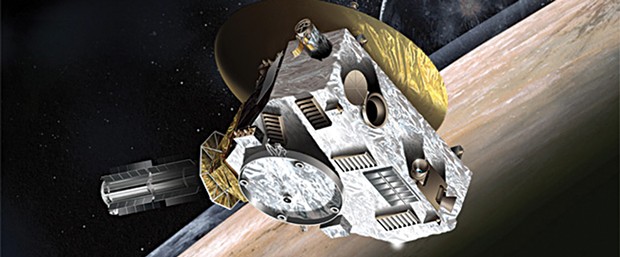[
{
"name": "Top Stories Video Pair",
"insertPoint": "7",
"component": "17087298",
"parentWrapperClass": "fdn-ads-inline-content-block",
"requiredCountToDisplay": "1"
}
]
On July 14, NASA's "New Horizons" spacecraft will zip past distant Pluto, 7,000 miles above its icy surface, while traveling at 25,000 mph. New Horizons will complete a saga that started 85 years ago this month in Flagstaff, Arizona. On Feb. 18, 1930, Clyde Tombaugh, a 23-year-old Kansas farm-boy-turned-astronomer, found Pluto by comparing telescopic photos of the same region of the night sky taken a week apart: Stars stay still, planets move.
As a planet, Pluto was always a bit suspect. Instead of moving roughly in the same plane as of that of Earth — the ecliptic — and the other planets, Pluto orbits at a steeply inclined 17 degrees. And unlike the eight "true" planets which swing around the sun in more-or-less well-mannered circles, Pluto's 248-year orbit is highly eccentric, swinging crazily between 30 and 50 times Earth's distance from the sun. (For 20 years of each orbit, Pluto is actually closer to the sun than Neptune, with which it shares a 2:3 resonance; for every two orbits Pluto makes around the Sun, Neptune makes three.)
Another oddity about Pluto is that it's really a binary object, since its main satellite, Charon, is relatively large, half the size of Pluto. Other than Earth and Pluto, the moons of the solar system are tiny compared to their parent bodies. Pluto and Charon, just 1,200 miles apart, are locked in orbit like a pair of waltzing dancers, with the same hemispheres always facing each other. Pluto itself is tiny, just two-thousandths the size of Earth.
Despite these anomalies, astronomers accepted Pluto as the ninth planet until 1992, when they started to question its classification. That's the year that sky watchers spotted a second body orbiting beyond Neptune, and since then they've found over 100 objects wandering those far reaches. Finally, in a controversial vote in 2006, the International Astronomical Union officially downgraded Pluto from "planet" to "dwarf planet."
The trans-Neptunian neighborhood is the outermost region of the sun's gravitational domain. Like Caesar's Gaul, the solar system can be divided into three parts. The middle region is the home of the gas giants Jupiter, Saturn, Uranus and Neptune, while the innermost is our own — the realm of the rocky planets Mercury, Venus, Earth and Mars. The region beyond Neptune holds particular interest for astronomers, not only because of Pluto and a handful of other dwarf planets, but because that's where innumerable "Kuiper Belt Objects" (KBOs) are found. KBOs — basically big lumps of frozen methane, ammonia and water — are comprised of 5-billion-year-old virgin material that could help us understand the early history of the solar system. The plan is for New Horizons to visit one or more KBOs after its Pluto flyby.
Before then, in addition to taking detailed photos, the 1,000-pound spacecraft will look for evidence of a subsurface ocean on Pluto, similar to those on four moons of Jupiter and Saturn (Europa, Ganymede, Enceladus, Titan). The presence of liquid water beneath Europa's icy surface is particularly intriguing to astronomers, who speculate on the possibility of finding microscopic life there. The discovery of a liquid water ocean on Pluto would similarly pose the question, Could life have arisen there? Too bad Tombaugh, who died in 1997, won't be around to complete the round of discovery he initiated on that February morning 85 years ago.
Barry Evans ([email protected]) finds it ironic that when New Horizons was launched, Pluto was officially designated a planet.
Comments (4)
Showing 1-4 of 4
more from the author
-
Doubting Shakespeare, Part 1: Stratfordians vs. anti-Stratfordians
- Apr 25, 2024
-
A Brief History of Dildos
- Apr 11, 2024
-
Eclipse!
- Mar 28, 2024
- More »
Latest in Field Notes
Readers also liked…
-
Trouble on the Line: The Reality Part 2
- Nov 3, 2022


































